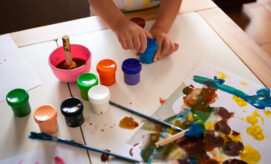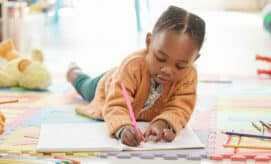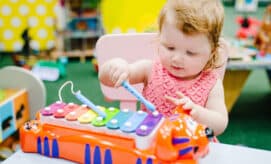How does Process Art Encourage Creativity?
When teachers emphasize the process rather than the product and provide a classroom environment that allows children to explore without constraints, children can let their imagination run free. These open-ended experiences allow children to create and enjoy the use of artistic materials. Children can express themselves, their thoughts, and their ideas through art. When children are handed projects with a specific outcome in mind, it can limit their self-expression by focusing on making a specific product rather than simply creating.
Early Childhood News’s article, Fostering Creativity, summarizes ideas for teachers to encourage creativity with preschoolers through open-ended experiences, using James Moran III’s suggestions below:
-
Adapt to children’s ideas rather than trying to structure the children’s ideas to fit the adult’s.
-
Use creative problem solving in all parts of the curriculum. Use the problems that naturally occur in everyday life.
Early Learning Benefits
NAEYC’S article, Supporting the Development of Creativity, lists the several benefits for children, including the following:
-
Physical Development: Small motor skills develop as children use glue, paints, and play with clay. These small motor skills are important for future writing skills and kindergarten readiness.
-
Language & Literacy Development: Engaging in art with children, leads to conversation that expands their vocabulary. Children are able to express ideas through art and this type of conversation supports literacy development.
-
Social and Emotional Development: Art is a form of self-exploration and self-expression. Engaging in creative projects supports the development of self-regulation and self-control as children practice focus and take pride in the work they have done when their project is complete.
Ideas for Curriculum
-
Collaging with Tear Art: An idea that worked really well for a Colorado pre-k teacher was to encourage the 3-5 year-olds in her class to create using only construction paper a glue stick. There was not a pattern nor were scissors used…Just tear and create!
-
Painting with unique materials: Try to use different materials as paint brushes! Use feathers, leaves, sponges, sticks, or kitchen utensils to make unique markings on paper. Talk with children about the different patterns and textures you see. Or swap out your paper for foil, clear plastic wrap, or even a rock!
-
Add music: Try to play music with a quick, upbeat tune and then switch to music with a slower and more peaceful melody, and ask children to paint how the music makes them feel. Watch as they allow their bodies to move to the different beats and then talk later about what they created.
-
Work together: Create a mural by allowing the children to all work on a large piece together! This type of project inspires collaboration, teamwork, and creative problem-solving.
NAEYC also suggests the following when Leading Process-Focused Art:
-
Approach art like open-ended play—for example, provide a variety of materials (including regularly introducing new materials) and see what happens as the child leads the art experience
-
Make art a joyful experience. Let children use more paint, more colors, and make more and more artwork
-
Provide plenty of time for children to carry out their plans and explorations and let children come and go from their art at will
-
Notice and comment on what you see “Look at all the yellow dots you painted”
-
Take art materials outside in the natural light
-
Display children’s books with artful illustrations, such as those by Eric Carle






